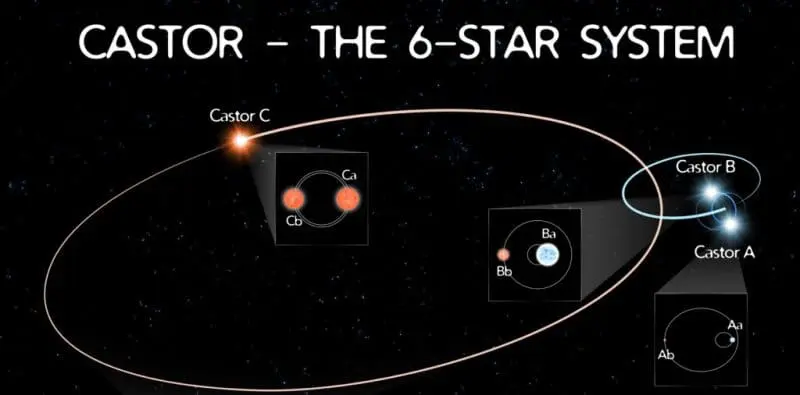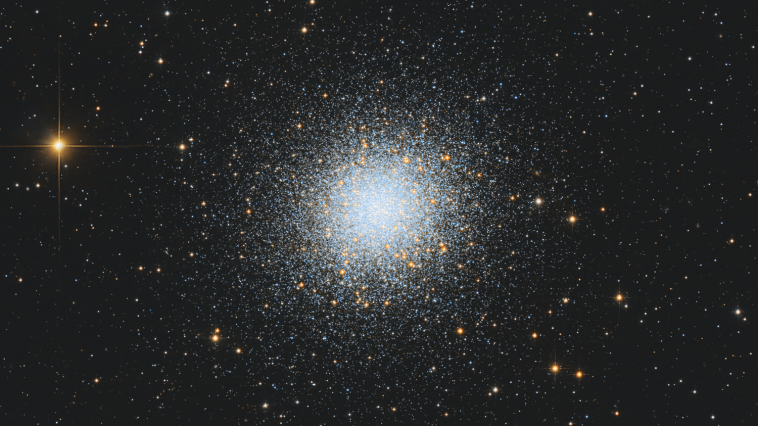[Originally published as the first part of Stellar Astronomy: Part 8 – Stellar Clusters and Populations]
Stars often exist as binary pairs — two or more stars that orbit their common center of mass. However, even larger numbers of stars can exist in close proximity to each other — a star cluster — which can consist of hundreds to hundreds of thousands of stars. Single stars, binaries, and star clusters exist as part of a much larger structure — a galaxy — which can contain millions to trillions of stars. Furthermore, the composition of stars varies slightly depending on where they are located.
Binary Stars
Most stars exist as part of a binary pair.
In this sense, our sun is somewhat unusual in that it does not. But our nearest neighbor, Alpha Centauri, is a multi-star system. At a distance of 4.3 light-years, Alpha Centauri is the third brightest star in our night sky, but can only be seen from latitudes south of 30 degrees north.1
The brightest two stars, Alpha Centauri A and B, orbit close to each other and appear as one star to the naked eye (and hence share the name “Alpha Centauri”), but they appear as separate stars in a small telescope. They orbit each other with a period of 79 years at a distance that varies between 11.2 AU and 35.6 AU. That’s about the distance from the sun to Saturn and Neptune, respectively. The brighter star, Alpha Centauri A, is a G-type star about 10% more massive than the sun and 50% more luminous. Alpha Centauri B is class K, slightly smaller and cooler at 0.9 times the mass and half the luminosity of the sun.
A third star of this system, Alpha Centauri C, orbits much farther out at 13,000 AU, or 0.21 light-years. It is a class M red dwarf and is too faint to be seen with the unaided eye. But it is well separated from the other two in our night sky and is therefore often given a separate name: Proxima Centauri. It is currently the closest star to the sun.
Some multiple-star systems are much more complicated.
Consider Castor, a bright star in the constellation Gemini. Although Castor appears as one bright star to the unaided eye, it actually consists of six individual stars. Telescopes reveal three visual stars, two of which orbit each other while a third orbits their common center of mass. However, each of these visual components consists of two stars in a very tight orbit. To watch all six stars perform their celestial dance over time would be fascinating.

Star Clusters
There are two types of star clusters: open clusters and globular clusters. Open clusters consist of a few hundred to a few thousand stars and have a random shape. In our winter evening sky (or summer morning sky), two open clusters are easily visible to the unaided eye.2 These are the Pleiades and the Hyades.
The Pleiades appears like a tiny “little dipper” and should not be confused with the constellation Ursa Minor (The Little Dipper). To the unaided eye, six or seven stars are visible very close to each other. These are type B stars and appear blue in color. Binoculars reveal even more stars, and a modest telescope reveals hundreds of stars.
The Hyades cluster appears close to the Pleiades but is larger and more spread out. Find it by locating the bright red star Aldebaran. Aldebaran is not actually part of the cluster but is directly in front of it from our perspective on Earth. A star that is directly in front of a cluster but does not belong to it is called an interloper. Think of Aldebaran as “photo-bombing” the Hyades star cluster.
Many other open clusters are visible in binoculars, such as the Beehive cluster in our winter evening sky, or the Ptolemy and Butterfly clusters in our summer evening sky. A given open cluster may or may not be gravitationally bound. In other words, should the Lord tarry, these stars will either remain together orbiting their common center of mass (bound) or will disperse into space (unbound).
Globular clusters are even more spectacular.
They consist of hundreds of thousands of stars and always have a spherical shape, with the number density of stars increasing near the core. The nearest globular clusters exist at much greater distances than the nearest open clusters and are not easily seen with the unaided eye.
Binoculars will reveal a globular cluster as a tiny fuzzy ball, but individual stars will not be visible. It takes a telescope with a six-inch or larger diameter mirror to begin to resolve individual stars in the nearest globular clusters. An eight-inch or ten-inch telescope works even better. These telescopes will reveal hundreds of thousands of stars in a compact, spherical region.
Although they may look very crowded, globular clusters are often around fifty light-years in diameter. Globular clusters are gravitationally bound — their stars orbit the common center of mass.
Nearly all globular clusters are found in the summer evening sky, with very few visible in the winter. This is because globular clusters themselves orbit the core of our galaxy. In the summer evening sky, we are looking toward the center of our galaxy and thus see the majority of globular clusters.
In the winter evening sky, we are looking in the opposite direction, and very few globular clusters orbit farther from the core than we do. This was one of the first lines of evidence that led astronomers to realize that our solar system is not in the center of our galaxy.
Footnotes
- As such, it cannot be seen from the United States except for Hawaii, Florida, Southern Texas, and Southern Louisiana.
- References to summer or winter are given from a northern hemisphere perspective. Readers located in the southern hemisphere should reverse these.







